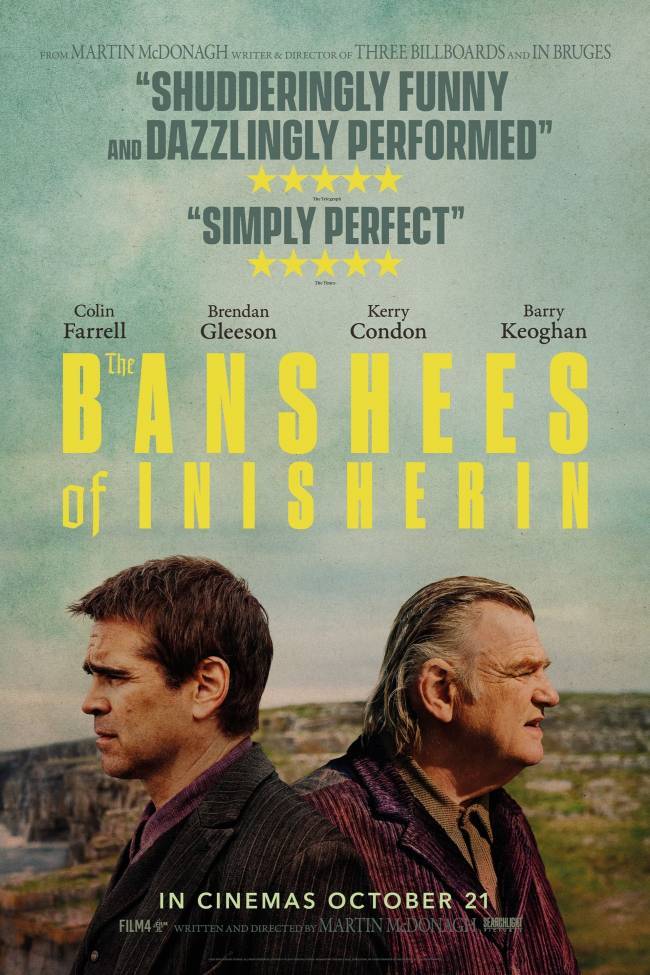Is it a masterpiece? It’s pretty darn close.
Could it win Best Picture? Director? Original Screenplay? Lead Actor? Supporting Actor? Supporting Actress? Why the hell not.
This new film from acclaimed writer-director Martin McDonagh is almost certainly his best work to date. This is not a statement uttered lightly, considering that his most recent work, Three Billboards Outside Ebbing, Missouri was nominated for a total of 7 Academy Awards. For those unfamiliar with McDonagh, he is one of few playwrights who has successfully transitioned to the big screen. In 2004, at the age of only 34, McDonagh successfully directed his first short film, which won the Academy Award for live action short. Not bad for his first foray into film after transitioning from the stage. Since then, he has written and directed four feature films, all of which have received varying degrees of critical acclaim. Banshees of Inisherin is his most “play-like” film to date in many ways, with the use of minimal sets, but is simultaneously his strongest piece of pure filmmaking as well. His nuanced understanding of blocking, framing, and colour, along with his forever-masterful dialogue has surely cemented his position as a leading auteur of this new generation of filmmakers.
Banshees of Inisherin stars Colin Farrell and Brendan Gleeson, but this is not the first time these two actors have worked with McDonagh. In fact, Farrel and Gleeson have worked with McDonagh on two previous occasions, including their joint efforts in the acclaimed In Bruges. It is widely known that Farrell and Gleeson are friends in the “real world”, and this almost certainly aided in their near-perfect delivery of two friends falling out of friendship.
In particular, Farrell’s performance as Pádraic Súilleabháin is likely the only one capable of competing with Brendan Fraser’s role in The Whale for Best Actor when it comes to award season. Without hyperbole, Farrell has positioned himself as one my favourite working actors after seeing his recent work. Not only has he provided an Oscar-worthy performance here, but he also brought forward a brilliant performance in After Yang, another one of my top films of the year, not to mention his role as The Penguin in Matt Reeves’ blockbuster The Batman. In The Banshees of Inisherin, Farrell provides a perfect balance of comedy and emotion, as a man who desires love and companionship above all else. At times, his dry delivery of lines is reminiscent of his performance in Yorgo Lanthimos’ The Lobster. His comedy will not knock you over the head, but if you allow yourself to sit back, it should be difficult to not find yourself laughing out loud throughout its runtime. As the film progresses, Farrell brilliantly showcases Pádraic’s descent into desperation.
Brendan Gleeson’s portrayal of Colm Doherty, Pádraic’s former partner-in-crime has also deservedly been receiving critical praise. While his performance is more subtle and subdued than Farrell’s, it is no less important to the success of the film. Gleeson softly shows a man fraught with angst over the need to “be someone”, ultimately becoming a tool of his own demise. This character shows the lengths that someone may go to leave a piece of themselves beyond. Of course, the ultimate irony that McDonagh suggests with this is that this pursuit may actually strip one’s being away while still on this Earth. At the risk of veering too far off track here, this notion reminds me of the psychological theory of terror management. Essentially, this theory provides a model for how humans protect themselves against the inevitability of death. Conscious concerns of death are combated by immediate, proximal defenses. Once concerns of death have been moved to the subconscious, distal defenses take over, in which an individual develops a cultural worldview to “transcend death”. This frequently comes in the form of religious beliefs, but to Colm, this comes in the form of his music. If he can create music that lasts for generations, he will have become successful in “transcending death”. Psychological rant aside, Gleeson perfectly shows this desire to “transcend”, as his character resorts to increasingly desperate means to do so.
Farrell and Gleeson’s desperation is perfectly juxtaposed with Kerry Condon’s portrayal of Siobhán Súilleabháin, Pádraic’s sister, and the only one on the island who seems capable of rational thought and purposeful action. To Pádraic, she is everything. She serves as a beacon of knowledge, compassion, and what it means to be “nice” (even when she won’t let the donkey inside the house). Essentially, Siobhán serves to ground the other characters on the island, and Condon is able to say so much with so little, making her performance that much more worthy of praise. Even when she is not uttering many words, she expresses the dissonance Siobhán carries with her: the depth of love for her brother, but also the desire to be free. Without Condon at the helm, this character could have very easily slipped into the background, but instead, Siobhán helps to frame the emotional experiences of every other member of the small island community.
The other supporting performance most worthy of attention is Barry Keoghan as Dominic Kearney. Keoghan has demonstrated, in his young career, an aptitude for embracing a wide range of unique characters. The role of Dominic is certainly no different. He brings together a combination of the physical and emotive to bring humanity to a character that could have otherwise dissolved into a collection of stereotypes and tropes. It would not be entirely shocking to see Keoghan’s supporting performance supersede Gleeson’s when it comes to award season, but either actor would be deserving.
Beyond the performances, the simple beauty of this film needs to be acknowledged. From Carter Burwell’s brilliant score, evoking a sense of childlike wonder, to the long shots of the Irish landscape, this film is gorgeous. Burwell intentionally avoided an “Irish” sounding score, and instead opted for a sound reminiscent of old fairy tales. On the surface, this may seem like an odd choice, but in reality, it perfectly framed the narrative as one of longing. These feelings are matched by the landscape. Each “neighbour” is a long walk through pastures of green, and the vast ocean is always looming in the backdrop. Mostly filmed on Achill Island, it has already been added to my bucket list of travel destinations.
Ultimately though, what makes this film so powerful is its effectiveness in showing devastation on both a micro and macro level. On the surface, Banshees is a simple narrative, showing the decay of a friendship. However, it is illustrating a lot more than that. In the background, the Irish civil war wages on, which serves as a metaphor for what we are witnessing between Pádraic and Colm. There is a battle between two brothers, with neither one achieving the goals they hope to reach. In this conflict, there are no winners, but rather an unending destruction rooted in the pride of man. This forces the audience to reflect on their own struggles, both internal and on a grander scale. Perhaps there is work that we can do to mend these wounds, or perhaps, as the film alludes to, there are forces of fate that are simply unavoidable, no matter how desperately we try to hide from them.
This one is a must-watch for any film lover.






Thanks for the recommendation. Saw it tonight and it was brilliant!
Pingback: Top 22 Films of 2022 - Points of Reviews